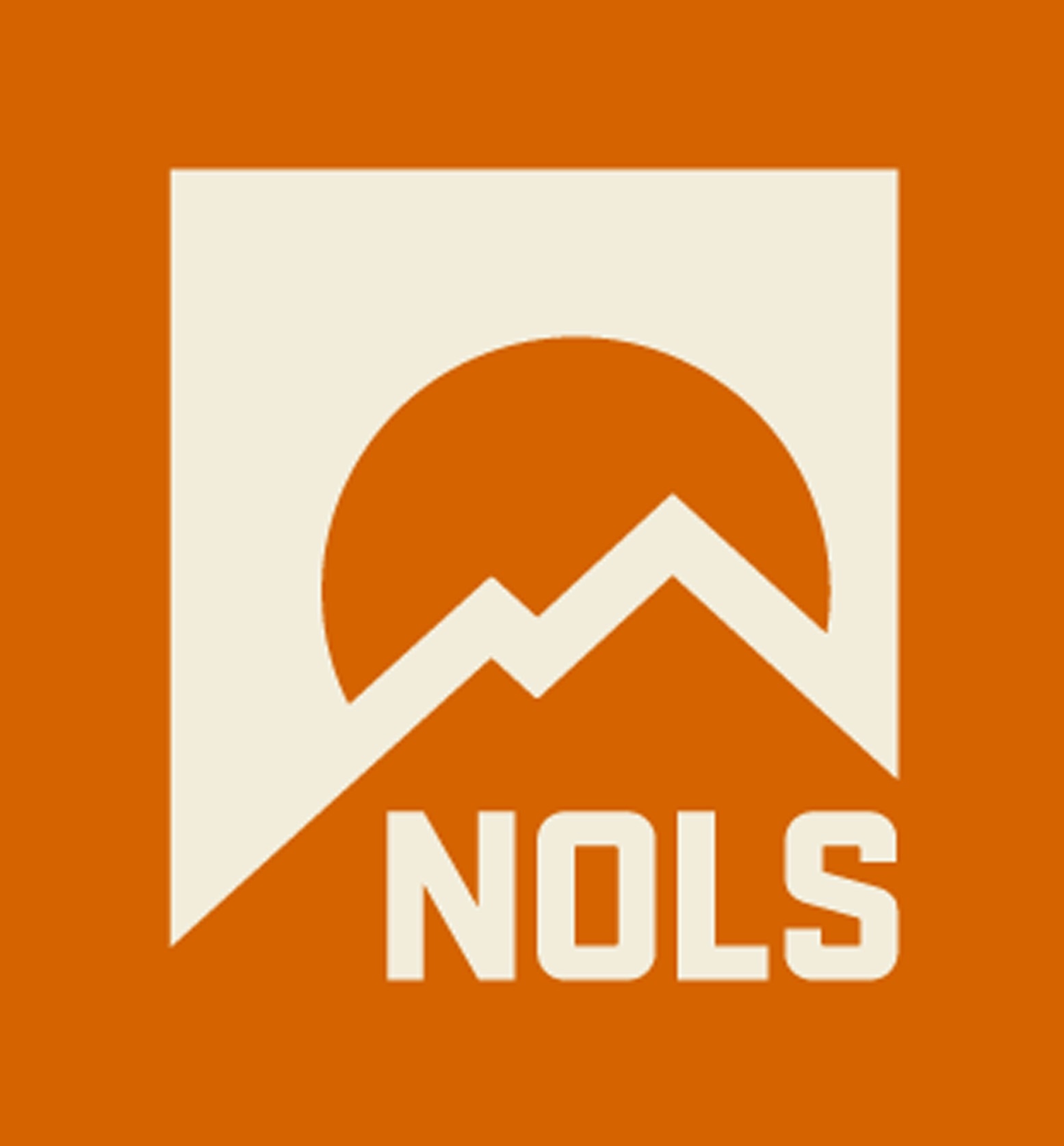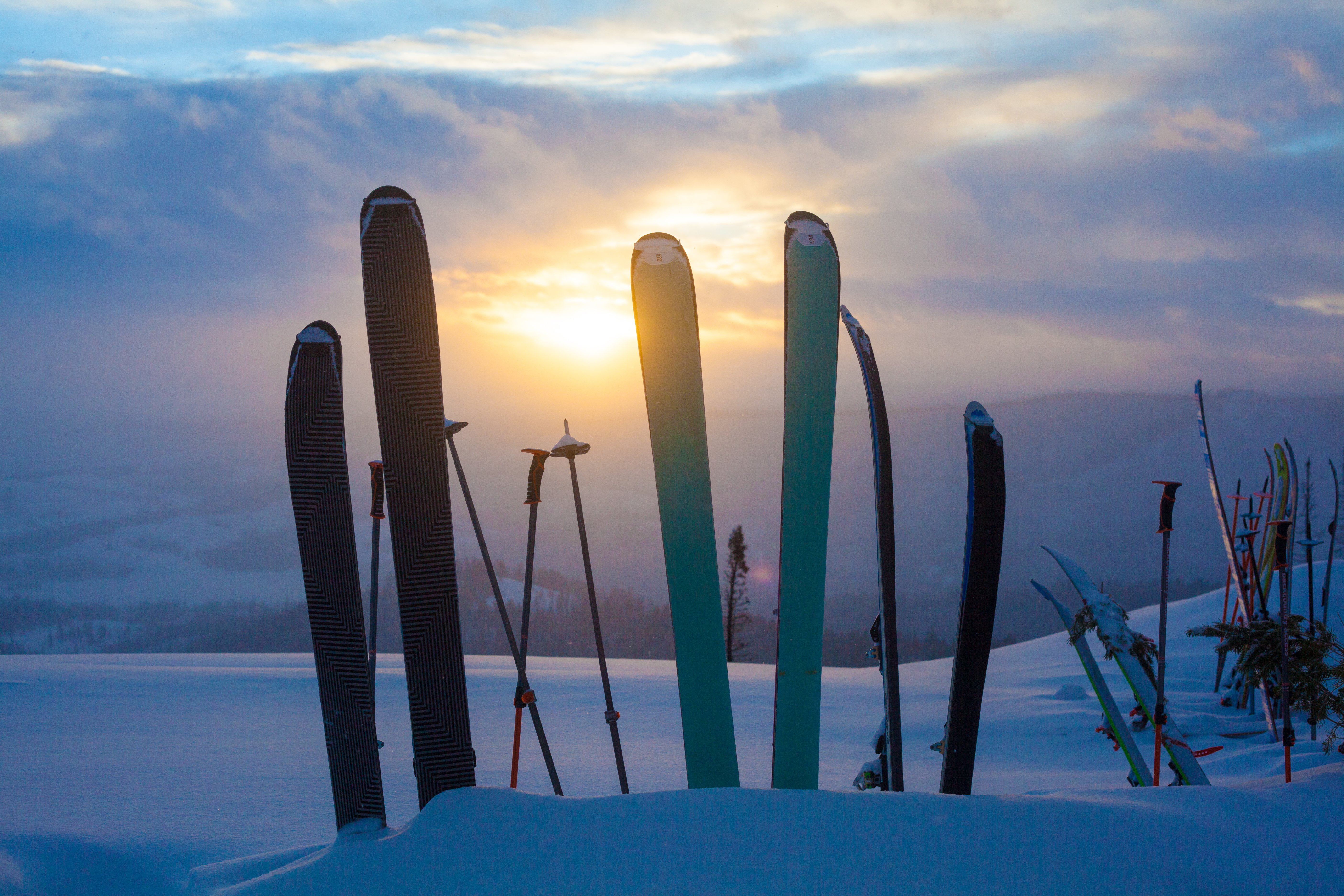Imagine the gravity-defying thrill of shredding down slopes on a snowboard combined with the versatility and uphill mobility of skiing. With a splitboard, backcountry travelers can carve through untouched powder on descents and climb diverse backcountry terrain.
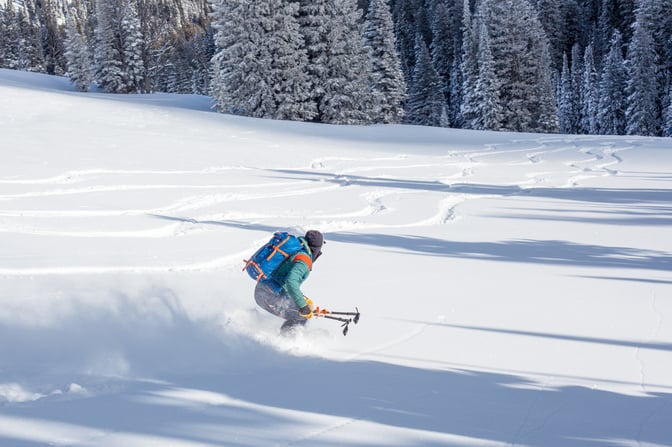 Photo by Molly Hagbrand
Photo by Molly Hagbrand
However, while splitboarding offers an exhilarating experience, it comes with its set of risks, particularly when venturing into avalanche-prone areas of the backcountry. If you're interested in learning how to splitboard, know that avalanche training and certification for backcountry exploration is an essential part of your journey.
At NOLS, we offer backcountry avalanche training courses, as well as skiing courses and snowboarding courses that blend backcountry touring, avalanche training certification, and the technical skill development needed for an immersive wilderness experience.
Embarking on the journey of splitboarding requires a keen awareness of its challenges, particularly within the context of the inherent risks of backcountry travel. Understanding the potential dangers, especially for those without proper avalanche training, is crucial.
To prepare for splitboarding adventures, consider leveling up your skills with a NOLS avalanche training and certification course. Prioritize proper avalanche safety training and explore the intricacies of splitboard gear and mastering techniques that facilitate a seamless transition from uphill to downhill mode in the backcountry.
What Is Splitboarding?
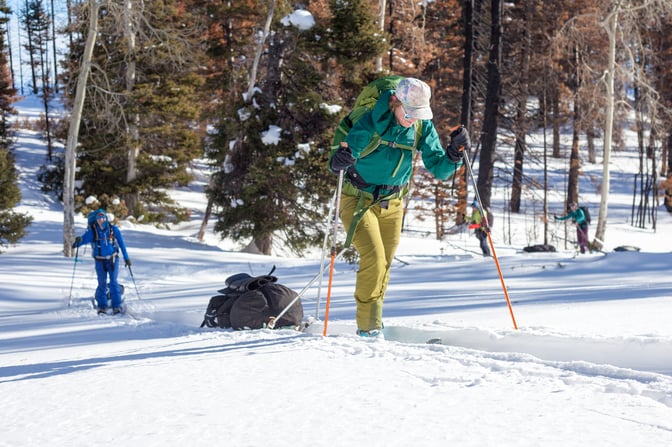 Photo by Molly Hagbrand
Photo by Molly Hagbrand
Splitboarding is a dynamic winter sport that melds elements of snowboarding and backcountry skiing. Designed for those seeking the untamed beauty of remote areas, it allows riders to explore untouched and remote snow-covered landscapes that are inaccessible by traditional ski resorts.
How A Splitboard Works:
At the core of the splitboarding experience lies the specialized gear that enables this unique fusion of snowboarding and backcountry exploration.
While outwardly resembling a regular snowboard, the defining feature of a splitboard is its capability to be split into two skis for ascending slopes, much like backcountry skiing, and seamlessly reunite for downhill descents. This makes a splitboard an ideal vehicle for facilitating uphill climbs and navigating flat terrain.
This transformative process is facilitated by bindings that release the snowboard into two independent skis, each of which can then be outfitted with climbing skins. These skins deliver the essential traction needed for ascending slopes, granting riders access to pristine backcountry landscapes that would otherwise be challenging to reach.
By incorporating climbing skins onto the base of each ski, traction is maximized, effectively preventing any backward slides during uphill climbs. This addition ensures stability and control, making the ascent smoother and more manageable for splitboarding enthusiasts.
Touring Mode & Uphill Mode: From Snowboarding to Skiing
When preparing to navigate flat and uphill terrain, the splitboard rider transitions the board into touring mode by separating it into two skis, unclipping the split hooks and tail tips, and aligning the splitboard bindings to face forward.
Riders then attach climbing skins to the bottom of each of the two skis. These adhesive strips have a textured surface—similar to carpeting—that adds grip and provides traction against the snow, helping to reduce the risk of backsliding. Collapsible poles are another valuable accessory for maintaining balance and aiding in the climb.
Downhill Mode: From Skiing to Snowboarding
When gearing up to descend downhill, the splitboard can be reconfigured into its snowboard shape. Look for a flat, stable surface to make the transition process more manageable, and begin by removing the climbing skins from the base of each split ski.
Then, remove the splitboard-specific bindings from ski mode and securely lock them into snowboard mode. This typically involves engaging a mechanism that firmly connects the two split skis, transforming them into a cohesive snowboard shape.
Splitboard bindings play a crucial role in the transition between ascent and descent modes. They securely fasten the splitboard together for downhill riding and release to allow for free-heel climbing. The gear's adaptability is further enhanced by the integration of features like heel risers, which optimize climbing efficiency on steep terrain.
Next, verify that all split hooks, nose and tail clips are securely fastened. This step is crucial for stability during the downhill descent. Double-check that everything is properly aligned and locked, then give the entire splitboard setup a once-over to confirm stability.
The Essentials of Splitboarding
Splitboarding involves a continuous learning process, and it's essential to start with a solid foundation of skills and knowledge of splitboarding and avalanche training before entering the backcountry.
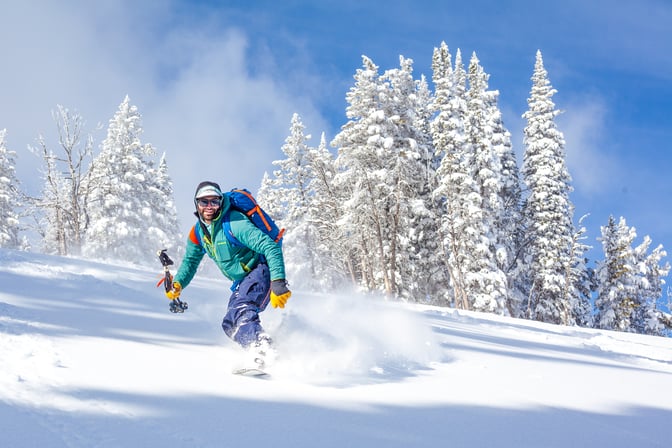 Photo by Molly Hagbrand
Photo by Molly Hagbrand
Non-Negotiables:
We want to hammer home that no one – not even those with proper training – should venture into avalanche terrain without these non-negotiables and a buddy who has these non-negotiables as well.
- Avalanche Transceiver: A crucial device that emits signals and receives signals from others, aiding in locating buried individuals.
- Avalanche Probe: An extendable pole used to probe the snowpack to pinpoint the location of a buried person.
- Avalanche Shovel: A sturdy, collapsible shovel designed for efficiently digging out buried individuals during rescue operations.
Backcountry Gear Checklist:
In addition to the non-negotiables listed above, we urge anyone traveling the backcountry to carry the following with them:
- Avalanche Airbag Pack: An advanced safety feature that, when deployed, helps the rider stay on the snow surface during an avalanche.
Snow Study Kit: Includes a snow saw, crystal card, and thermometer for analyzing snowpack conditions and assessing avalanche risk. - Avalanche Safety Whistle: A loud whistle for signaling in case of emergencies, enhancing communication in challenging conditions.
- Emergency Communication Device: Fully charged cell phone, two-way radio, or satellite communicator for calling for help in case of emergencies.
- Wilderness First Aid Kit: Compact kit with essentials such as bandages, pain relievers, and other medical supplies.
- Navigation Tools: Map, compass, and possibly a GPS device for backcountry navigation.
- Headlamp: Essential for low-light conditions or unexpected delays during backcountry travel.
- Emergency Shelter: Lightweight shelter or space blanket for protection against the elements during emergencies.
- Multi-Tool or Knife: Handy for various on-the-go adjustments and repairs.
- Personal Locator Beacon (PLB): An additional emergency communication device that sends distress signals and location information to rescue authorities.
- Snow Saw: Essential for cutting blocks of snow for snow profiles and testing stability.
- Snow Study Kit: Includes a snow saw, crystal card, and thermometer for analyzing snowpack conditions and assessing avalanche risk.
- Snowpack Field Book: A notebook for recording observations and snowpack data during backcountry travel.
Splitboarding Gear Essentials:
- Splitboard: The fundamental piece of gear, a splitboard is a snowboard that can be split into two skis for uphill travel and rejoined for downhill descents. Choose a splitboard that suits your riding style and the type of terrain you'll be exploring.
- Climbing Skins: Adhesive strips that attach to the base of each splitboard ski, climbing skins provide traction on snow during ascents. They prevent sliding backward, allowing you to climb uphill efficiently.
- Splitboard Bindings: Splitboard-specific bindings play a crucial role in transitioning between touring and descending modes. Split bindings secure the splitboard for downhill riding and release for free-heel climbing during ascents, a functionality distinct from regular snowboard bindings.
- Collapsible Poles: Collapsible poles are essential for maintaining balance and aiding in climbing and touring mode. Adjustable poles allow you to customize the length based on the terrain and personal preference.
- Splitboard Boots or Snowboard Boots: These boots are specially designed to clip into your splitboard, whether it’s in uphill or downhill mode.
- Snowboard Helmet: Essential head protection during descents.
- Snowboard Goggles: High-quality eye protection from snow, wind, and UV rays.
Splitboarding Techniques for Success
Uphill Climbing Techniques
Travelling uphill can be physically demanding, requiring endurance and resilience. Splitboard riders employ specific climbing techniques during uphill travel, including the kick turn for negotiating sharp turns on steeper sections of the climb and sidehilling for traverses and slopes with a significant angle.
The kick turn minimizes the effort required to change direction, while sidehilling optimizes weight distribution, reducing the strain on the rider's muscles. Both techniques not only conserve energy but also contribute to maintaining a steady pace. Riders can navigate challenging terrain efficiently, avoiding unnecessary pauses and interruptions in their ascent.
To execute a kick turn, riders lift the tail of one ski, pivot it 180 degrees, and swing the other ski around. This swift maneuver minimizes the space needed to change direction, making it an efficient choice for navigating challenging, narrow terrain. The kick turn not only conserves energy but also ensures a fluid and continuous uphill progress.
Sidehilling involves angling the splitboard to match the slope and distributing weight evenly across both skis. Riders minimize the risk of sliding and optimize grip by maintaining a perpendicular position to the hillside. Sidehilling is not only a technique for conserving energy but also a skill that allows for controlled and efficient progress across varied terrain.
Downhill Descent Techniques
Proper weight distribution is crucial for stability and control. Unlike traditional snowboarding, where weight is centered, splitboarders shift their weight towards the back foot during descents to keep the nose of the board afloat in deep snow.
While splitboards allows for riders to switch between ski touring and snowboarding, they are not ideal for downhill skiing. The split skis lack the stability and control provided by traditional downhill skis.
Because of this, splitboarders leverage snowboarding skills for downhill descents, focusing on toeside and heelside edges. These edges, facing toes and heels, guide turns by shifting weight accordingly. Body rotation aligns shoulders with desired direction, ensuring a smooth turn. Speed control involves maintaining a forward lean, slightly bent knees, and centered weight. S-turns, transitioning from toe-side to heel-side, aid in speed management. Edge control, achieved by gently pressing on edges, regulates acceleration. When quick deceleration is needed, shifting weight to the back foot and pressing the heel edge acts as a brake. These techniques empower splitboarders to navigate slopes with control and precision.
What's The Point Of A Splitboard?
A Vehicle for Remote Backcountry Access
Splitboarding offers exclusive access to pristine areas beyond the reach of traditional means. The dual functionality of splitboarding not only enhances the overall experience but also empowers riders to access remote and challenging areas that would be impractical or impossible to reach with traditional snowboarding or skiing equipment. This heightened versatility and freedom enable exploration beyond the confines of marked trails, unveiling a world of untouched powder and hidden stashes.
However, it's essential to acknowledge and address the inherent risks associated with traveling via splitboard through avalanche-prone backcountry terrain.
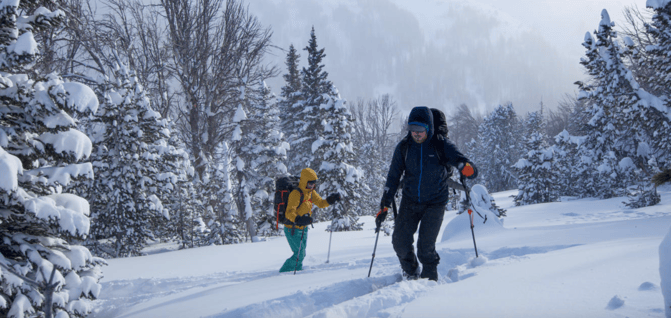 Photo by Molly Hagbrand
Photo by Molly Hagbrand
Splitboarding & Avalanche Rescue Training
Splitboarding in backcountry areas brings along a set of responsibilities and potential dangers, particularly when it comes to avalanche-prone terrain. Avalanche training becomes a crucial component for splitboarders seeking to explore untouched snow in the wilderness. This essential training equips riders with the skills and knowledge needed to navigate through areas where avalanches are a real threat.
At NOLS, avalanche rescue training covers various aspects, including understanding snowpack stability, recognizing potential avalanche hazards, and mastering the use of essential safety gear such as avalanche beacons, probes, and shovels. Splitboarders learn to assess the risk of avalanches, make informed decisions about route choices, and, if necessary, respond promptly and effectively in case of an avalanche incident.
For those enticed by the allure of splitboarding, NOLS highly recommends comprehensive training in backcountry safety and avalanche awareness. This educational investment not only promotes personal safety but also contributes to building a community of responsible and well-prepared backcountry enthusiasts. Minimizing risk and maximizing the chances of an enjoyable experience in the wilderness begins with acquiring the necessary skills and knowledge to navigate the unique challenges presented by splitboarding and backcountry touring.
Risk Management in the Backcountry
Terrain Assessment:
Understanding the terrain is foundational for safe backcountry exploration. Recognizing challenges such as avalanche risk, steep slopes, and unpredictable weather is critical. Conduct a thorough assessment of the landscape, considering the potential impact of various elements on your route. Identify potential hazards like cornices, crevasses, or unstable snowpack. Regularly update your knowledge of the area's conditions by consulting local resources, experienced guides, or avalanche centers. This proactive approach ensures you are well-informed about the specific challenges posed by the terrain you are navigating.
Avalanche Awareness:
Avalanche awareness is paramount in snow-covered environments. Acquire the skills to assess avalanche terrain and recognize warning signs like recent avalanches, unstable snow, or audible collapses. Understand the principles of snowpack stability and how it can vary across different slopes and aspects. Equip yourself with essential avalanche safety gear, including a beacon to locate buried individuals, a probe to pinpoint their exact location, and a shovel for efficient snow removal during rescue operations. Regularly practice using this equipment to maintain proficiency in emergency situations.
Weather Monitoring:
Vigilant weather monitoring is crucial for adapting to changing conditions in the backcountry. Stay updated on weather forecasts, paying attention to forecasts specifically tailored for mountainous regions. Sudden weather shifts can impact visibility, alter snow conditions, and pose overall safety risks. Plan your activities based on anticipated weather patterns, adjusting your route or timing accordingly. Carry the necessary clothing and gear to handle unexpected weather changes, ensuring you are prepared for a variety of conditions.
Navigation Skills:
Developing robust navigation skills is essential for successful backcountry travel. Proficiency in map reading, compass use, and GPS navigation enhances your ability to navigate through diverse terrains.
Familiarize yourself with the area before embarking on a journey, studying topographic maps and noting key landmarks. Have a clear and flexible plan that includes alternate routes and emergency exits.
Regularly practice navigation techniques to maintain confidence in your ability to find your way in challenging conditions.
Effective Communication:
Effective communication is vital for group safety in the backcountry. Establish clear channels of communication within your group, ensuring that everyone is equipped with radios or other communication devices.
Define meeting points and protocols in case of separation, enabling efficient reunification. Regularly check in with group members to confirm their status and well-being. Clear communication fosters a collective understanding of the plan and safety procedures, promoting a cohesive and safe backcountry experience.
Ready To Learn How To Splitboard?
Embarking on a splitboarding adventure with NOLS is more than just a journey. It's an opportunity to discover the uncharted, challenge your limits, develop essential wilderness risk management skills, and forge lasting connections with nature and fellow enthusiasts. Explore our backcountry avalanche training courses, as well as skiing courses and snowboarding courses that blend backcountry touring, avalanche training certification, and the technical skill development needed for an immersive wilderness experience.
Check out related blog posts:
As a note, we recommend that total beginners take a few snowboarding lessons before enrolling in a NOLS course.
Written By
NOLS
NOLS is a nonprofit global wilderness school that seeks to help you step forward boldly as a leader.


